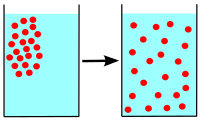
Photo from wikipedia
Abstract A diffusion-type time-temperature indicator (TTI) is known to have relatively low temperature dependency, which is an inherent weakness that causes an inevitable prediction error of food shelf-life: under- or… Click to show full abstract
Abstract A diffusion-type time-temperature indicator (TTI) is known to have relatively low temperature dependency, which is an inherent weakness that causes an inevitable prediction error of food shelf-life: under- or over-prediction. In this study, a TTI design method was developed to avoid the undesired overprediction. A polydiacetylene/silica nanocomposite (PDA/SiO2 NC) was used as the color-developing substance, which was loaded on the diffusion path of a microporous strip, with Tween 20 as the moving substance. When the Tween 20 reached the test line of the PDA/SiO2 NC, the line transitioned from blue to red, indicating the TTI endpoint. A principal design factor was used to accurately locate the test line. Four TTIs (TTI5°C, TTI10°C, TTI15°C, and TTI25°C) were designed in combination with the various test line locations, by matching the TTI endpoints with the food deterioration time during storage at 5, 10, 15 and 25 °C, respectively. Wheatgrass juice, a healthy drink with a relatively short shelf-life at 5 °C of about 5 days, was used as the food specimen. During storage at 5–25 °C, TTI25°C underpredicted the juice shelf-life, such that the TTI reached the endpoint before the wheatgrass juice attained the deterioration point. However, the other TTIs did not always underpredict the juice shelf-life. The optimal diffusion-type TTI design was found to locate the test line of the PDA/SiO2 NC matching the shelf-life of the tested food at the highest possible temperature during storage.
Journal Title: Journal of Food Engineering
Year Published: 2018
Link to full text (if available)
Share on Social Media: Sign Up to like & get
recommendations!